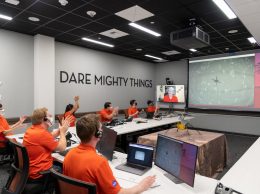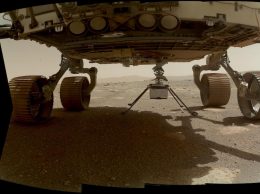An Atlas V rocket once destined for Mars will instead carry an observation satellite into orbit when it blasts off from Vandenberg Air Force Base on Sept. 16.
The United Launch Alliance, a joint venture between Lockheed Martin Space Systems and Boeing Defense, Space and Security, will launch the WorldView-4 observation satellite into orbit on a rocket originally scheduled to carry NASA’s Insight Lander into space. Liftoff is scheduled for 11:30 a.m.
DigitalGlobe, a Colorado-based imaging and data company, will operate the satellite once it reaches orbit.
Once in its 400 mile high orbit, WorldView-4 will map an area of 263,000 square miles each day, which will double the area of WorldView-3 maps. The satellite is also designed to see objects just 1 foot wide.
Originally planned for the spring of 2013 and named GeoEye-2, the satellite’s launch was delayed three years because of a merger. In January 2013, competitors DigitalGlobe and GeoEye merged operations of the independent fleets of imaging satellites.
At the time though both companies were developing similar imaging satellites, so the company had to effectively wait until the market demanded more imaging services from DigitalGlobe.
After the merger, the company decided to launch DigitalGlobe’s WorldView-3 satellite because it also was designed with short-wave infrared bands that can penetrate airborne particulates like fog, haze, dust or smoke.
Final preparations were made to the satellite Sept. 8 as technicians at Vandenberg encapsulated the satellite in a white, 4 meter tall protective nose cone.
The rocket, known as AV-062, nearly lifted off from Vandenberg in December and sat on the pad waiting to haul the Insight Lander to Mars. The probe was intended to land on Mars and drill into its surface to study Mars’ geological evolution, but a last-minute vacuum leak in the probe’s seismometer pushed the launch back to May 2018, when the next launch window to Mars opens.
The Sept. 16 launch will also happen about two weeks after the United Launch Alliance’s direct competitor, SpaceX, suffered a devastating setback after an explosion during a pre-launch test on the coast of Cape Canaveral, Fla.
Prior to the explosion, SpaceX had been scheduled to launch a Falcon 9 rocket from Vandenberg on Sept. 19 that would’ve carried 10 small Iridium satellites into orbit.
In May, SpaceX broke the ULA’s monopoly on U.S. military and national security satellite launches when it won an $83 million contract from the Air Force to launch a Global Positioning System satellite in 2018.
Both companies are expected to compete for another satellite launch services contract. Bidding for that contract closes on Sept. 19.
Col. Chris Moss, commander of the 30th Space Wing at Vandenberg, will have final authority over whether the Sept. 19 launch proceeds as scheduled.
“The combined 30th Space Wing and United Launch Alliance team has spent months preparing to ensure this launch is both safe and successful,” Moss said. “We have a very strong partnership with ULA and we’re proud to have teamed with them on this fantastic mission.”
• Contact Philip Joens at pjoens@pacbiztimes.com.






 Print
Print Email
Email

















